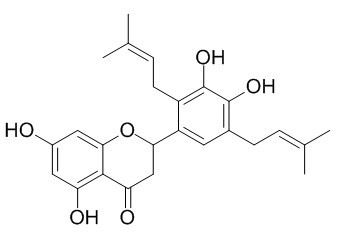(+/-)-Sigmoidin A
Sigmoidin A has moderate antioxidant, antimicrobial and anti-inflammatory activity.
Inquire / Order:
manager@chemfaces.com
Technical Inquiries:
service@chemfaces.com
Tel:
+86-27-84237783
Fax:
+86-27-84254680
Address:
1 Building, No. 83, CheCheng Rd., Wuhan Economic and Technological Development Zone, Wuhan, Hubei 430056, PRC
Providing storage is as stated on the product vial and the vial is kept tightly sealed, the product can be stored for up to
24 months(2-8C).
Wherever possible, you should prepare and use solutions on the same day. However, if you need to make up stock solutions in advance, we recommend that you store the solution as aliquots in tightly sealed vials at -20C. Generally, these will be useable for up to two weeks. Before use, and prior to opening the vial we recommend that you allow your product to equilibrate to room temperature for at least 1 hour.
Need more advice on solubility, usage and handling? Please email to: service@chemfaces.com
The packaging of the product may have turned upside down during transportation, resulting in the natural compounds adhering to the neck or cap of the vial. take the vial out of its packaging and gently shake to let the compounds fall to the bottom of the vial. for liquid products, centrifuge at 200-500 RPM to gather the liquid at the bottom of the vial. try to avoid loss or contamination during handling.
Molecules.2023, 28(8):3474.
CZECH MYCOLOGY2021, 73(1):1-19.
Nutrients.2020, 12(12):3607.
Nanjing University of Chinese Medicine2022, 345930.
Heliyon.2022, e12337.
Molecules.2023, 28(8):3503.
Biotechnol Bioeng.2020, 117(7):2198-2208.
Antioxidants (Basel).2021, 10(9):1435.
J Agric Food Chem.2024, 72(40):22237-22249.
Journal of Food and Drug Analysis2023, 31(3), 9.
Related and Featured Products
Planta Medica, 2009, 76(6):589-594.
Comparative Antioxidant, Prooxidant and Cytotoxic Activity of Sigmoidin A and Eriodictyol.[Reference:
WebLink]
Sigmoidin A (SGN) is a prenylated flavanone derivative of eriodictyol (ERD) with reported moderate antioxidant, antimicrobial and anti-inflammatory activity.
METHODS AND RESULTS:
Since ERD and other structurally similar antioxidant phenolic compounds have been shown to induce prooxidative macromolecular damage and cytotoxicity in cancer cells, the comparative IN VITRO effects of these structural analogues on cancer cell viability and Cu(II)-dependent DNA damage were studied. In the presence of Cu(II) ions, both SGN and ERD (7.4-236 microM) caused comparable concentration-dependent pBR322 plasmid DNA strand scission. The DNA damage induced by SGN and ERD could be abolished by ROS scavengers, glutathione (GSH) and catalase as well as EDTA and a specific Cu(I) chelator neocuproine. Both ERD and SGN readily reduce Cu(II) to Cu(I) suggesting a prooxidative mechanism of DNA damage.
CONCLUSIONS:
In a cell free system, ERD and SGN did also show comparable radical scavenging activity. SGN was, however, by an order of magnitude more cytotoxic to cancer cells than ERD and this effect was significantly attenuated by GSH suggesting a prooxidative mechanism of cell death. A depletion of intracellular GSH level by SGN in cancer cells is also demonstrated.
Planta Medica, 2004, 70(02):104-107.
Anti-Inflammatory Activities of Two Flavanones, Sigmoidin A and Sigmoidin B, from Erythrina sigmoidea[Reference:
WebLink]
Two prenylated flavanones isolated from Erythrina sigmoidea Hua (sigmoidin A and sigmoidin B) were studied for their ability to inhibit the stable 1,1-diphenyl-2-picrylhydrazyl (DPPH) free radical and arachidonic acid metabolism. In addition, the compounds were studied in two experimental models of inflammation induced in mouse ears by 12- O-tetradecanoylphorbol 13-acetate (TPA) and the phospholipase A (2)-induced mouse paw oedema.
METHODS AND RESULTS:
Both sigmoidins A and B proved to be potent scavengers of the DPPH radical, while the study of the inhibition of arachidonic acid metabolism demonstrated that these same compounds were selective inhibitors of 5-lipoxygenase, with no effect on cyclooxygenase-1 activity. Dose-response inhibitor potency was established for sigmoidin A (IC (50) = 31 microM). In the assay of phospholipase A (2)-induced mouse paw oedema, only the sigmoidin B derivative inhibited oedema formation at 60 min, showing a percentage of inhibition below that obtained with cyproheptadine (59 % vs. 74 %). In the TPA test, sigmoidins A and B decreased the induced oedema by 89 % and 83 %, respectively.
CONCLUSIONS:
This is the first time that the anti-inflammatory activity and antioxidant properties of these prenylflavanones have been reported. The results indicate that the compounds have different mechanisms of action depending on whether one or two prenyl groups are present in ring B.



